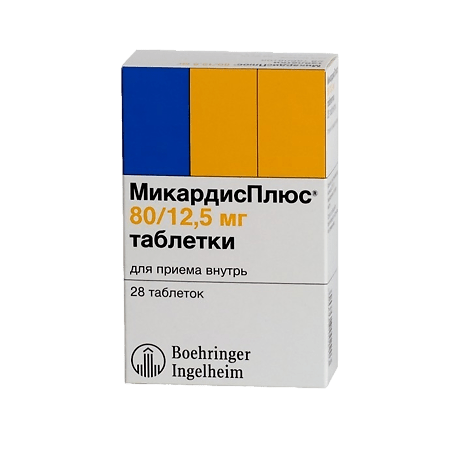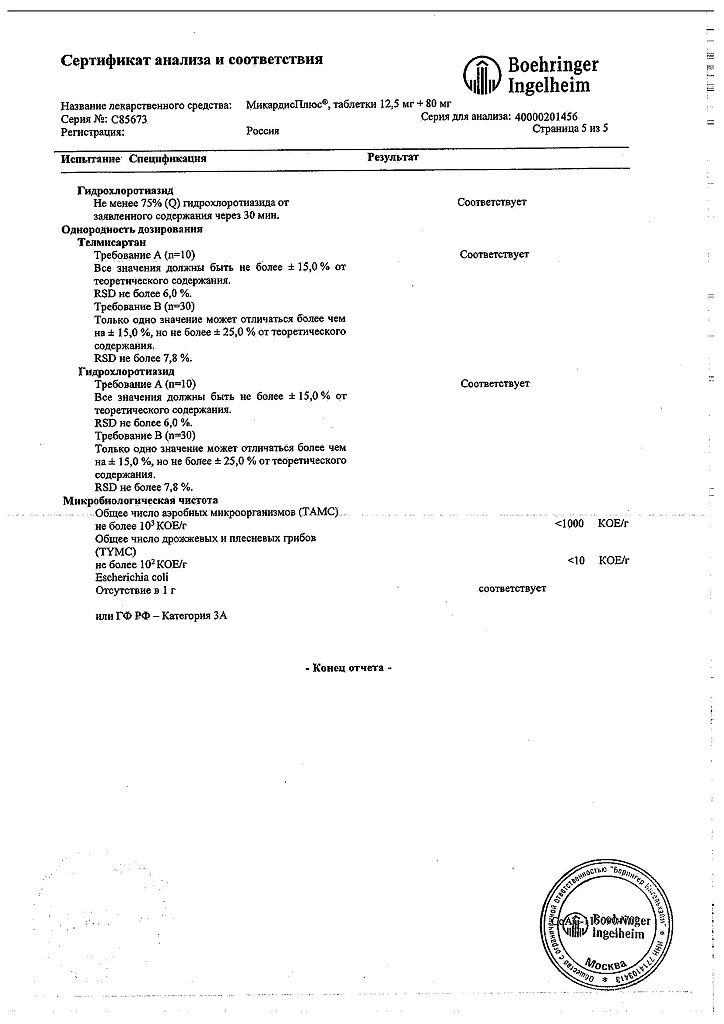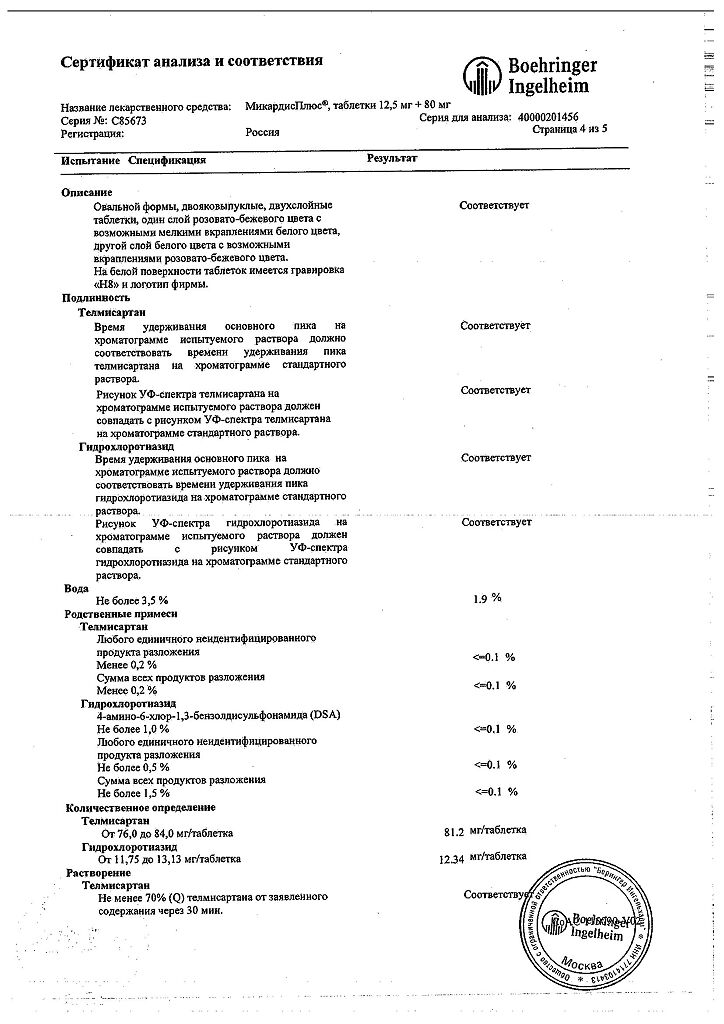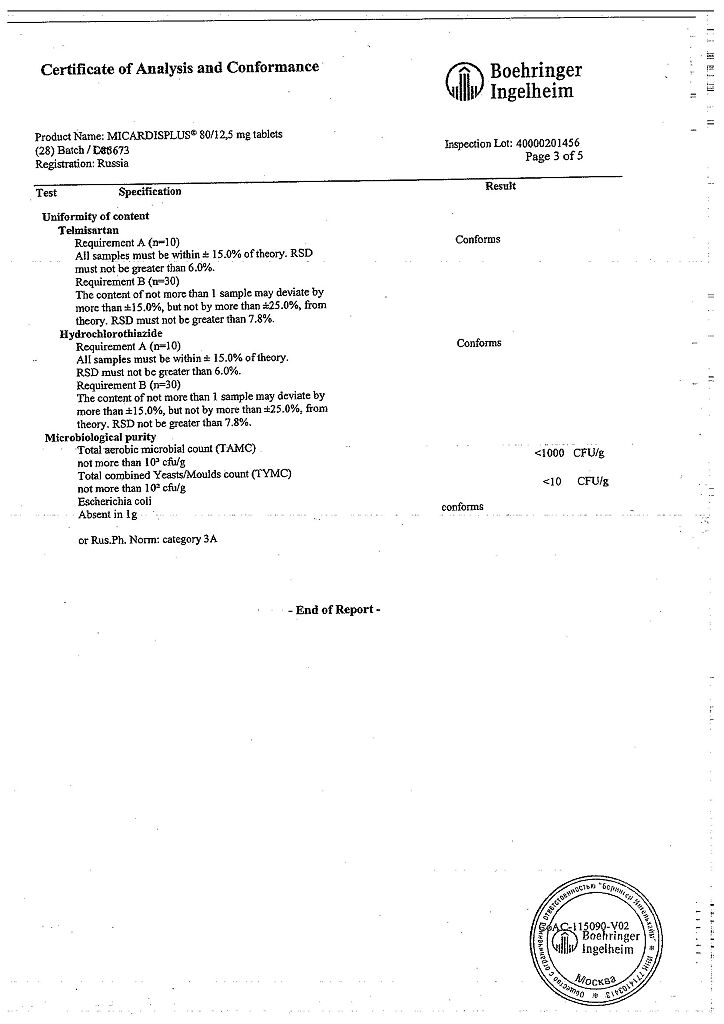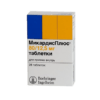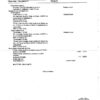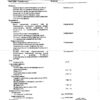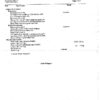No products in the cart.
Mycardis Plus, tablets 80 mg+12, 5 mg 28 pcs
€51.11 €42.59
Description
Micardis Plus is an antihypertensive drug. It is a combination of telmisartan (angiotensin II receptor antagonist) and hydrochlorothiazide (thiazide diuretic). Simultaneous use of these components leads to a greater antihypertensive effect than the use of each of them separately. Administration of MycardisPlus® 1 time/ leads to a significant gradual decrease of BP.
Telmisartan is a specific angiotensin II receptor antagonist. It has high affinity for the AT1 subtype of angiotensin II receptors, through which angiotensin II action is realized. Telmisartan displaces angiotensin II from binding to the receptor without having an agonist effect on this receptor. Telmisartan binds only to the AT1 subtype of angiotensin II receptor. Binding is prolonged. Telmisartan has no affinity for other receptors (including AT2 receptors) of angiotensin. The functional significance of these receptors, as well as the effect of their possible overstimulation by angiotensin II, the concentration of which increases when telmisartan is administered, has not been studied. Telmisartan leads to a decrease in blood aldosterone levels. Telmisartan does not block renin in blood and ion channels, does not block ACE, and does not inactivate bradykinin.
In patients with arterial hypertension, telmisartan reduces systolic and diastolic BP without affecting HR.
Telmisartan at a dose of 80 mg completely blocks the hypertensive effect of angiotensin II. Its action lasts for more than 24 hours, including the last 4 hours before taking the next dose. The onset of hypotensive action is noted within 3 h after the first dose of telmisartan. In case of abrupt telmisartan withdrawal, BP gradually returns to baseline levels without development of “withdrawal” syndrome.
Hydrochlorothiazide is a thiazide diuretic. Thiazide diuretics affect reabsorption of electrolytes in renal tubules by directly increasing sodium and chloride excretion (approximately equivalent amounts). Diuretic effect of hydrochlorothiazide leads to decreased RBC, increased plasma renin activity, increased aldosterone secretion and is accompanied by increased urinary potassium and bicarbonate content, as well as hypokalemia. When telmisartan is concomitantly administered, there is a tendency to stop potassium loss caused by these diuretics, presumably due to RAAS blockade.
Long-term use of hydrochlorothiazide reduces the risk of cardiovascular complications and mortality.
After taking hydrochlorothiazide, diuresis increases after 2 h, and the maximum effect is observed after about 4 h. The diuretic effect of the drug is maintained for about 6-12 h.
The maximum antihypertensive effect of MycardisPlus® is usually achieved 4 weeks after initiation of treatment.
Pharmacokinetics
The co-administration of hydrochlorothiazide and telmisartan has no effect on the pharmacokinetics of either drug component.
Telmisartan
Intake
In oral administration, the Cmax of telmisartan is reached within 0.5-1.5 h after administration. The absolute bioavailability of telmisartan in doses from 40 to 160 mg was 42% and 58%, respectively. When taken concomitantly with food, the bioavailability of telmisartan is slightly reduced with an AUC reduction of 6% for the 40 mg dose and about 19% for the 160 mg dose. Three hours after oral administration, plasma concentrations level off, regardless of whether the drug is taken with food or on an empty stomach. The pharmacokinetics of telmisartan with oral administration are nonlinear at doses of 20-160 mg with a more than proportional increase in plasma concentrations (Cmax and AUC) with increasing doses.
Distribution
Binding to plasma proteins is significant (over 99.5%), mainly with albumin and α1-glycoprotein. Vd for telmisartan is approximately 500 liters.
It penetrates the placental barrier and is detected in umbilical cord blood.
Metabolism
Telmisartan is metabolized by conjugation with glucuronic acid. The metabolite (acyl glucuronide) is pharmacologically inactive. Glucuronide is the main metabolite, which is determined only in humans.
Elimation
The majority of the administered dose (more than 97%) is excreted with the bile, and then with the feces. Minor amounts of telmisartan are excreted in the urine. Total plasma clearance is more than 1500 ml/min. T1/2 is more than 20 h.
Pharmacokinetics in special clinical cases
In women, telmisartan plasma concentrations are 2-3 times higher than in men. However, an increase in the hypotensive effect is not observed in women.
The pharmacokinetic parameters of telmisartan do not differ significantly in young and elderly patients.
Renal excretion does not affect telmisartan clearance. Based on the level of excretion in patients with mild to moderate renal impairment (CKR of 30 to 60 mL/min), no dosing adjustment is required. Telmisartan is not excreted by dialysis.
Pharmacokinetic studies in patients with hepatic impairment have shown an increase in absolute bioavailability to almost 100%. The T1/2 is not altered in hepatic insufficiency.
Hydrochlorothiazide
Intake
After oral administration of MycardisPlus® Cmax of hydrochlorothiazide is reached within 1-3 hours. Absolute bioavailability is estimated by cumulative renal excretion of hydrochlorothiazide and is about 60%.
Distribution
Bound to plasma proteins by 64%. Vd – 0.8±0.3 l/kg.
Metabolism and excretion
It is not metabolized in the human body and is excreted practically unchanged in the urine. About 60% of the dose taken orally is eliminated within 48 hours. Renal clearance is about 250 – 300 ml/min. T1/2 is 10-15 h.
Pharmacokinetics in special clinical cases
In women there is a tendency to increase plasma concentrations of hydrochlorothiazide. However, an increase in the hypotensive effect is not observed in women.
In patients with impaired renal function the excretion rate of hydrochlorothiazide is reduced. The T1/2 of hydrochlorothiazide at CK of 90 ml/min increases and is about 34 hrs.
Indications
Indications
Arterial hypertension (if telmisartan or hydrochlorothiazide are ineffective as monotherapy).
Active ingredient
Active ingredient
Composition
Composition
Active ingredients:
telmisartan 40 and 80 mg,
hydrochlorothiazide 12.5 mg;
auxiliary substances:
povidone,
meglumine,
sodium hydroxide,
sorbitol,
magnesium stearate,
microcrystalline cellulose,
Red iron oxide,
sodium starch glycolate,
lactose monohydrate,
corn starch
How to take, the dosage
How to take, the dosage
Micardis Plus is taken regardless of meals, once a day
Interaction
Interaction
Special Instructions
Special Instructions
Contraindications
Contraindications
With caution: MicardisPlus should be administered in impaired liver function or advanced liver disease; bilateral renal artery stenosis or artery stenosis of the single kidney; impaired renal function; condition after renal transplantation; decreased RBC due to prior diuretic therapy, restricted intake of table salt, diarrhea, or vomiting; chronic heart failure; aortic and mitral valve stenosis; obstructive hypertrophic cardiomyopathy; diabetes mellitus; CHD; systemic lupus erythematosus; gout.
Side effects
Side effects
1) – side effects expected based on experience with telmisartan.
2) – side effects expected on the basis of experience with hydrochlorothiazide.
Respiratory system: upper respiratory tract infections (including bronchitis, pharyngitis, sinusitis), dyspnea1), dyspnea, respiratory distress syndrome (including pneumonia and pulmonary edema)2).
Cardiovascular system: bradycardia1), tachycardia1), arrhythmias2), marked BP decrease1), orthostatic hypotension2), necrotizing angiitis (vasculitis2) , chest pain1).
CNS disorders: agitation, fear, depression1)2) , anxiety2) , dizziness, fainting1) , insomnia1) , staggering when walking2) , paresthesias2) .
Digestive system: abdominal pain, diarrhea, dyspepsia, gastritis, anorexia2), decreased appetite2), sialoadenitis2), dry mouth1), flatulence1), vomiting1), constipation2), pancreatitis2) , impaired liver function1), jaundice (hepatocellular or cholestatic)2).
Endocrine system: loss of control of hypoglycemia in diabetes mellitus.
Metabolic disorders: hypercholesterolemia, hyperuricemia, hypokalemia, hyperkalemia, hyponatremia2) , decrease in BOD2) , electrolyte metabolism disorder2) , hyperglycemia2) , hypercalcemia1).
Hematopoietic system: eosinophilia1), anemia (including aplastic anemia2), hemolytic anemia2), suppression of medullary hematopoiesis2), leukopenia2), neutropenia/agranulocytosis2), thrombocytopenia1)2).
Urinary system disorders: urinary system infections, interstitial nephritis2), renal dysfunction2), acute renal failure1), glucosuria2).
Muscular system disorders: arthralgia, arthrosis, back pain, lower back pain, myalgia, crampy twitching of the calf muscles (crunches)1), tendinitis-like symptoms1), weakness1)2), muscle spasm2).
Allergic reactions: anaphylactic reactions2) , eczema, erythema1), pruritus1), cutaneous lupus-like reactions2), cutaneous vasculitis2), photosensitivity reactions2), rash2), cutaneous lupus erythema reactivation2), toxic epidermal necrolysis2), angioedema, urticaria and other similar reactions (as with other angiotensin II antagonists).
Senses: visual acuity abnormalities1), transient blurred vision2), xanthopsia2), vertigo.
Reproductive system disorders: decreased potency.
Laboratory findings: decreased hemoglobin1), increased levels of uric acid1), creatinine1), liver enzymes1), blood creatine phosphokinase1), triglycerides2).
Others: flu-like symptoms, fever2) , increased sweating1).
The use of thiazide diuretics may impair glucose tolerance.
Overdose
Overdose
Pregnancy use
Pregnancy use
Similarities
Similarities
Additional information
| Shelf life | 3 years |
|---|---|
| Conditions of storage | The drug should be stored in a moisture-proof place at a temperature not exceeding 25 ° C. |
| Manufacturer | Boehringer Ingelheim Pharma GmbH & Co. |
| Medication form | pills |
| Brand | #Н/Д |
Related products
Buy Mycardis Plus, tablets 80 mg+12, 5 mg 28 pcs with delivery to USA, UK, Europe and over 120 other countries.

